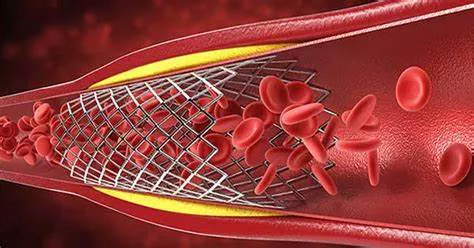Stent thrombosis is a serious and potentially life-threatening complication that can occur after the placement of a stent in a coronary artery. This event involves the formation of a blood clot (thrombus) within the stent, which can obstruct blood flow and lead to myocardial infarction (heart attack) or even death. Understanding the different types of stent thrombosis, their causes, risk factors, and management strategies is crucial for improving patient outcomes and guiding clinical practice.
4 Types of Stent Thrombosis
Stent thrombosis is classified based on the timing of the thrombotic event relative to the stent implantation. The key types include:
- Acute Stent Thrombosis
- Subacute Stent Thrombosis
- Late Stent Thrombosis
- Very Late Stent Thrombosis
1. Acute Stent Thrombosis
Acute stent thrombosis occurs within the first 24 hours after stent placement. This type is often associated with procedural factors and technical aspects of the stent implantation.
SEE ALSO: How to Diagnose Blocked Heart Arteries
Causes and Risk Factors
Incomplete Stent Expansion: Insufficient expansion of the stent can leave areas prone to clot formation.
Poor Stent Apposition: If the stent does not adequately adhere to the vessel wall, blood flow disruption can lead to thrombosis.
Periprocedural Complications: Factors such as arterial dissection, residual thrombus, and procedural trauma can trigger acute thrombosis.
Platelet Activation: The procedure itself can activate platelets, promoting clot formation.
Management
Antithrombotic Therapy: Immediate administration of antithrombotic agents, including aspirin and P2Y12 inhibitors, is essential.
Procedural Optimization: Ensuring optimal stent deployment, including adequate expansion and apposition, can reduce the risk.
Intracoronary Imaging: Tools such as intravascular ultrasound (IVUS) or optical coherence tomography (OCT) can guide precise stent placement.
2. Subacute Stent Thrombosis
Subacute stent thrombosis occurs between 24 hours and 30 days post-implantation. This period is critical as the endothelium begins to heal and integrate the stent into the vessel wall.
Causes and Risk Factors
Medication Noncompliance: Nonadherence to prescribed antiplatelet therapy can significantly increase the risk.
Dual Antiplatelet Therapy (DAPT) Resistance: Some patients may have reduced response to antiplatelet drugs, increasing thrombotic risk.
Procedural Factors: Similar to acute thrombosis, poor stent deployment can contribute to subacute events.
Prothrombotic Conditions: Underlying conditions like hypercoagulability can predispose patients to subacute thrombosis.
Management
Strict Adherence to DAPT: Ensuring patient compliance with dual antiplatelet therapy is crucial during this period.
Monitoring and Adjusting Therapy: Regular follow-up to assess and adjust antiplatelet therapy based on patient response.
Prompt Intervention: In cases of suspected subacute thrombosis, prompt angiographic evaluation and possible re-intervention are necessary.
3. Late Stent Thrombosis
Late stent thrombosis occurs between 1 month and 1 year after stent placement. This type is less common but still poses significant risks.
Causes and Risk Factors
Delayed Endothelialization: Drug-eluting stents (DES) can delay endothelial healing, increasing the risk of late thrombosis.
Ongoing Inflammation: Persistent inflammation at the stent site can contribute to thrombus formation.
Discontinuation of DAPT: Premature discontinuation of dual antiplatelet therapy can precipitate late thrombosis.
Management
Continued Antiplatelet Therapy: Extended duration of dual antiplatelet therapy may be necessary, especially with DES.
Regular Follow-up: Ongoing monitoring to detect signs of late thrombosis and manage underlying risk factors.
Patient Education: Educating patients on the importance of medication adherence and lifestyle modifications.
4. Very Late Stent Thrombosis
Very late stent thrombosis occurs more than 1 year after stent implantation. This type is primarily associated with drug-eluting stents.
Causes and Risk Factors
Neoatherosclerosis: Development of new atherosclerotic plaques within the stent can lead to very late thrombosis.
Chronic Inflammation: Long-term inflammatory response to the stent and drug can contribute to thrombus formation.
Mechanical Factors: Late stent malapposition and fracture can also be implicated.
Management
Long-term Antiplatelet Therapy: In some cases, prolonged or even lifelong antiplatelet therapy may be required.
Lifestyle Modifications: Addressing risk factors such as smoking, hypertension, and hyperlipidemia to reduce thrombotic risk.
Re-evaluation of Stent Patency: Periodic imaging studies to assess stent integrity and patency.
Risk Factors for Stent Thrombosis
Several factors can increase the likelihood of stent thrombosis across all types:
Patient-related Factors: Age, diabetes, renal insufficiency, and genetic predispositions can elevate risk.
Lesion-related Factors: Complex lesions, bifurcation stenting, and long stents are associated with higher thrombotic risk.
Device-related Factors: Differences in stent design, drug coatings, and stent materials can impact thrombosis rates.
Therapy-related Factors: Inadequate antiplatelet therapy, drug resistance, and interactions with other medications are critical considerations.
Prevention And Future Directions
Preventing stent thrombosis involves a multifaceted approach:
Optimal Stent Selection and Deployment: Choosing the appropriate stent type and ensuring meticulous deployment techniques.
Personalized Antithrombotic Therapy: Tailoring antiplatelet therapy to individual patient profiles and risk factors.
Technological Advancements: Continued innovation in stent design and drug formulations to enhance safety and efficacy.
Patient Education and Follow-up: Ensuring patients understand the importance of medication adherence and regular follow-up.
Conclusion
Stent thrombosis remains a significant challenge in interventional cardiology, with acute, subacute, late, and very late types presenting distinct clinical scenarios. By understanding the causes, risk factors, and management strategies for each type, clinicians can better prevent and address this complication, ultimately improving patient outcomes and advancing the field of cardiovascular medicine.

